
The Space Shuttle program was the fourth human spaceflight program carried out by the U.S. National Aeronautics and Space Administration (NASA), which accomplished routine transportation for Earth-to-orbit crew and cargo from 1981 to 2011. Its official name, Space Transportation System (STS), was taken from a 1969 plan for a system of reusable spacecraft of which it was the only item funded for development. It flew 135 missions and carried 355 astronauts from 16 countries, many on multiple trips.

A space station is a spacecraft capable of supporting a human crew in orbit for an extended period of time and is therefore a type of space habitat. It lacks major propulsion or landing systems. An orbital station or an orbital space station is an artificial satellite. Stations must have docking ports to allow other spacecraft to dock to transfer crew and supplies. The purpose of maintaining an orbital outpost varies depending on the program. Space stations have most often been launched for scientific purposes, but military launches have also occurred.

The Automated Transfer Vehicle, originally Ariane Transfer Vehicle or ATV, was an expendable cargo spacecraft developed by the European Space Agency (ESA), used for space cargo transport in 2008–2015. The ATV design was launched to orbit five times, exclusively by the Ariane 5 heavy-lift launch vehicle. It effectively was a larger European counterpart to the Russian Progress cargo spacecraft for carrying upmass to a single destination—the International Space Station (ISS)—but with three times the capacity.
Draper Laboratory is an American non-profit research and development organization, headquartered in Cambridge, Massachusetts; its official name is The Charles Stark Draper Laboratory, Inc. The laboratory specializes in the design, development, and deployment of advanced technology solutions to problems in national security, space exploration, health care and energy.

The Constellation program was a crewed spaceflight program developed by NASA, the space agency of the United States, from 2005 to 2009. The major goals of the program were "completion of the International Space Station" and a "return to the Moon no later than 2020" with a crewed flight to the planet Mars as the ultimate goal. The program's logo reflected the three stages of the program: the Earth (ISS), the Moon, and finally Mars—while the Mars goal also found expression in the name given to the program's booster rockets: Ares. The technological aims of the program included the regaining of significant astronaut experience beyond low Earth orbit and the development of technologies necessary to enable sustained human presence on other planetary bodies.

Dream Chaser is an American reusable lifting-body spaceplane developed by Sierra Space. Originally intended as a crewed vehicle, the Dream Chaser Space System is set to be produced after the Dream Chaser Cargo System cargo variant is operational. The crewed variant is planned to carry up to seven people and cargo to and from low Earth orbit.
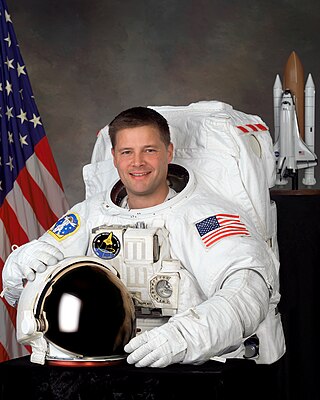
Douglas Harry "Wheels" Wheelock is an American engineer and astronaut. He has flown in space twice, logging 178 days on the Space Shuttle, International Space Station, and Russian Soyuz. On July 12, 2011, Wheelock announced that he would be returning to active duty with the United States Army in support of Operation Enduring Freedom. He is currently working with NASA to test the Orion spacecraft at the Glenn Research Center in Plum Brook, Ohio.
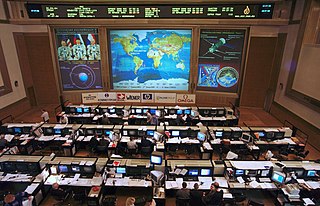
Flight controllers are personnel who aid space flight by working in such Mission Control Centers as NASA's Mission Control Center or ESA's European Space Operations Centre. Flight controllers work at computer consoles and use telemetry to monitor various technical aspects of a space mission in real-time. Each controller is an expert in a specific area and constantly communicates with additional experts in the "back room". The flight director, who leads the flight controllers, monitors the activities of a team of flight controllers, and has overall responsibility for success and safety.
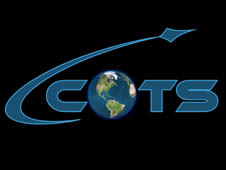
Commercial Orbital Transportation Services (COTS) was a NASA program to coordinate the development of vehicles for the delivery of crew and cargo to the International Space Station by private companies. The program was announced on January 18, 2006 and successfully flew all cargo demonstration flights by September 2013, when the program ended.

Spaceflight began in the 20th century following theoretical and practical breakthroughs by Konstantin Tsiolkovsky, Robert H. Goddard, and Hermann Oberth, each of whom published works proposing rockets as the means for spaceflight. The first successful large-scale rocket programs were initiated in Nazi Germany by Wernher von Braun. The Soviet Union took the lead in the post-war Space Race, launching the first satellite, the first animal, the first human and the first woman into orbit. The United States would then land the first men on the Moon in 1969. Through the late 20th century, France, the United Kingdom, Japan, and China were also working on projects to reach space.

The process of assembling the International Space Station (ISS) has been under way since the 1990s. Zarya, the first ISS module, was launched by a Proton rocket on 20 November 1998. The STS-88 Space Shuttle mission followed two weeks after Zarya was launched, bringing Unity, the first of three node modules, and connecting it to Zarya. This bare 2-module core of the ISS remained uncrewed for the next one and a half years, until in July 2000 the Russian module Zvezda was launched by a Proton rocket, allowing a maximum crew of three astronauts or cosmonauts to be on the ISS permanently.
ARCTUS was a proposed design by Astrotech Corporation and developed with its partners Lockheed Martin, United Launch Alliance, Cimarron and Odyssey Space Research for a robotic spacecraft that would deliver cargo to the International Space Station, NASA COTS program. ARCTUS was planned to be launched by an Atlas V rocket. Its pressurized cargo module would return to Earth and be recovered with a mid-air retrieval operation.

The Russian Orbital Segment (ROS) is the name given to the components of the International Space Station (ISS) constructed in Russia and operated by the Russian Roscosmos. The ROS handles Guidance, Navigation, and Control for the entire Station.

The retirement of NASA's Space Shuttle fleet took place from March to July 2011. Discovery was the first of the three active Space Shuttles to be retired, completing its final mission on March 9, 2011; Endeavour did so on June 1. The final shuttle mission was completed with the landing of Atlantis on July 21, 2011, closing the 30-year Space Shuttle program.

The NASA Launch Services Program (LSP) is responsible for procurement of launch services for NASA uncrewed missions and oversight of launch integration and launch preparation activity, providing added quality and mission assurance to meet program objectives. LSP operates under the NASA Space Operations Mission Directorate (SOMD).

Orbital-D1, also known as Orb-D1, and Cygnus 1, was the first flight of the Cygnus cargo spacecraft developed by Orbital Sciences Corporation. It was named after the late NASA astronaut and Orbital Sciences executive G. David Low. The flight was carried out by Orbital Sciences under contract to NASA as Cygnus' demonstration mission in the Commercial Orbital Transportation Services (COTS) program. The mission launched on 18 September 2013 at 14:58:02 UTC. Cygnus was the seventh type of spacecraft to visit the International Space Station (ISS), after the crewed Soyuz and Space Shuttle, and uncrewed Progress, ATV, HTV and Dragon 1.

Dragon, also known as Dragon 1 or Cargo Dragon, was a class of fourteen partially reusable cargo spacecraft developed by SpaceX, an American private space transportation company. The spacecraft flew 23 missions between 2010 and 2020. Dragon was launched into orbit by the company's Falcon 9 launch vehicle to resupply the International Space Station (ISS).

NG-13, previously known as OA-13, was the fourteenth flight of the Northrop Grumman robotic resupply spacecraft Cygnus and its thirteenth flight to the International Space Station (ISS) under the Commercial Resupply Services (CRS-1) contract with NASA. The mission launched on 15 February 2020 at 20:21:01 UTC after nearly a week of delays. This is the second launch of Cygnus under the CRS-2 contract.
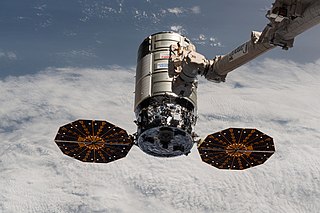
NG-14, previously known as OA-14, was the fifteenth flight of the Northrop Grumman robotic resupply spacecraft Cygnus and its fourteenth flight to the International Space Station under the Commercial Resupply Services (CRS-1) contract with NASA. The mission was launched on 3 October 2020, at 01:16:14 UTC.
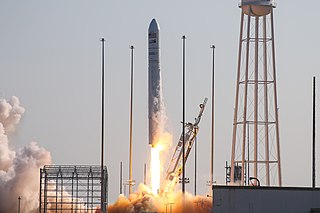
Cygnus NG-16, previously known as Cygnus OA-16, was the sixteenth flight of the Northrop Grumman robotic resupply spacecraft Cygnus and its fifteenth flight to the International Space Station (ISS) under the Commercial Resupply Services (CRS-2) contract with NASA. The mission was launched on 10 August 2021 at 22:01:05 UTC, for a (planned) 90-day mission at the ISS. This was the fifth launch of Cygnus under the CRS-2 contract.


















